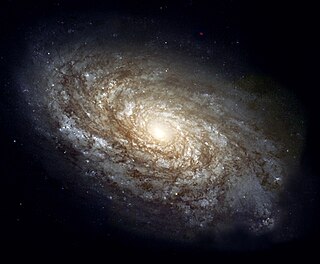
A galaxy is a system of stars, stellar remnants, interstellar gas, dust, and dark matter bound together by gravity. The word is derived from the Greek galaxias (γαλαξίας), literally 'milky', a reference to the Milky Way galaxy that contains the Solar System. Galaxies, averaging an estimated 100 million stars, range in size from dwarfs with less than a thousand stars, to the largest galaxies known – supergiants with one hundred trillion stars, each orbiting its galaxy's center of mass. Most of the mass in a typical galaxy is in the form of dark matter, with only a few percent of that mass visible in the form of stars and nebulae. Supermassive black holes are a common feature at the centres of galaxies.

A molecular cloud, sometimes called a stellar nursery (if star formation is occurring within), is a type of interstellar cloud, the density and size of which permit absorption nebulae, the formation of molecules (most commonly molecular hydrogen, H2), and the formation of H II regions. This is in contrast to other areas of the interstellar medium that contain predominantly ionized gas.
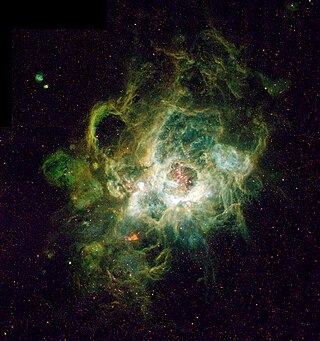
An H II region or HII region is a region of interstellar atomic hydrogen that is ionized. It is typically in a molecular cloud of partially ionized gas in which star formation has recently taken place, with a size ranging from one to hundreds of light years, and density from a few to about a million particles per cubic centimetre. The Orion Nebula, now known to be an H II region, was observed in 1610 by Nicolas-Claude Fabri de Peiresc by telescope, the first such object discovered.

An elliptical galaxy is a type of galaxy with an approximately ellipsoidal shape and a smooth, nearly featureless image. They are one of the three main classes of galaxy described by Edwin Hubble in his Hubble sequence and 1936 work The Realm of the Nebulae, along with spiral and lenticular galaxies. Elliptical (E) galaxies are, together with lenticular galaxies (S0) with their large-scale disks, and ES galaxies with their intermediate scale disks, a subset of the "early-type" galaxy population.

The Galactic Center is the barycenter of the Milky Way and a corresponding point on the rotational axis of the galaxy. Its central massive object is a supermassive black hole of about 4 million solar masses, which is called Sagittarius A*, a compact radio source which is almost exactly at the galactic rotational center. The Galactic Center is approximately 8 kiloparsecs (26,000 ly) away from Earth in the direction of the constellations Sagittarius, Ophiuchus, and Scorpius, where the Milky Way appears brightest, visually close to the Butterfly Cluster (M6) or the star Shaula, south to the Pipe Nebula.

A starburst galaxy is one undergoing an exceptionally high rate of star formation, as compared to the long-term average rate of star formation in the galaxy, or the star formation rate observed in most other galaxies.

NGC 6946, sometimes referred to as the Fireworks Galaxy, is a face-on intermediate spiral galaxy with a small bright nucleus, whose location in the sky straddles the boundary between the northern constellations of Cepheus and Cygnus. Its distance from Earth is about 25.2 million light-years or 7.72 megaparsecs, similar to the distance of M101 in the constellation Ursa Major. Both were once considered to be part of the Local Group, but are now known to be among the dozen bright spiral galaxies near the Milky Way but beyond the confines of the Local Group. NGC 6946 lies within the Virgo Supercluster.

In astronomy a superbubble or supershell is a cavity which is hundreds of light years across and is populated with hot (106 K) gas atoms, less dense than the surrounding interstellar medium, blown against that medium and carved out by multiple supernovae and stellar winds. The winds, passage and gravity of newly born stars strip superbubbles of any other dust or gas. The Solar System lies near the center of an old superbubble, known as the Local Bubble, whose boundaries can be traced by a sudden rise in dust extinction of exterior stars at distances greater than a few hundred light years.

NGC 1705 is a peculiar lenticular galaxy and a blue compact dwarf galaxy (BCD) in the southern constellation of Pictor, positioned less than a degree to the east of Iota Pictoris, and is undergoing a starburst. With an apparent visual magnitude of 12.6 it requires a telescope to observe. It is estimated to be approximately 17 million light-years from the Earth, and is a member of the Dorado Group.

Andromeda IV is an isolated irregular dwarf galaxy. The moderate surface brightness, a very blue color, low current star formation rate and low metallicity are consistent with it being a small (background) dwarf irregular galaxy, perhaps similar to Local Group dwarfs such as IC 1613 and Sextans A. Arguments based on the observed radial velocity and the tentative detection of the RGB tip suggest that it lies well outside the confines of the Local Group.
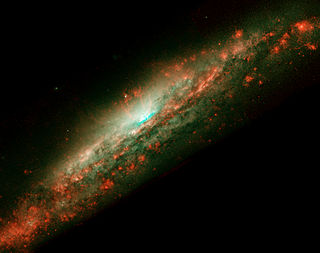
NGC 3079 is a barred spiral galaxy about 50 million light-years away, and located in the constellation Ursa Major. The galaxy was discovered by German-British astronomer William Herschel on 1 April 1790.

Galaxy mergers can occur when two galaxies collide. They are the most violent type of galaxy interaction. The gravitational interactions between galaxies and the friction between the gas and dust have major effects on the galaxies involved, but the exact effects of such mergers depend on a wide variety of parameters such as collision angles, speeds, and relative size/composition, and are currently an extremely active area of research. Galaxy mergers are important because the merger rate is a fundamental measurement of galaxy evolution and also provides astronomers with clues about how galaxies grew into their current forms over long stretches of time.

NGC 1672 is a barred spiral galaxy located in the constellation Dorado. It was discovered by the astronomer James Dunlop on November 5, 1826. It was originally unclear whether it was a member of the Dorado Group, with some sources finding it to be a member and other sources rejecting its membership. However, recent tip of the red-giant branch (TRGB) measurements indicate that NGC 1672 is located at the same distance as other members, suggesting it is indeed a member of the Dorado Group.

Holmberg IX is a dwarf irregular galaxy and a satellite galaxy of M81, located in the constellation of Ursa Major. It is of the Magellanic type of Galaxy as it is similar to the Small Magellanic Cloud, neighbour galaxy to Milky Way Galaxy. The galaxy is named after Erik Holmberg who first described it though it was first found by Sidney van den Bergh. Based on the observed age distribution of stars it contains, a whole 20% of its stellar mass formed within the last 200 Myr, making it the youngest nearby galaxy. It is also home to one of two yellow supergiant eclipsing binary systems.

RCW 120 is an emission nebula and H II region in the southern Milky Way and located some 4,300 light-years from Earth.
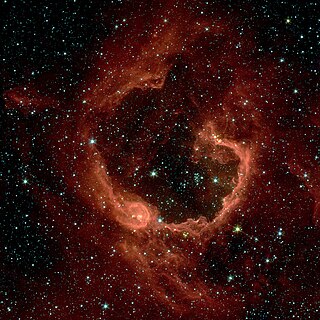
RCW 79 is an emission nebula in the constellation Centaurus.

NGC 7090 is a spiral galaxy in the southern constellation of Indus located about 31 million light-years away. English astronomer John Herschel first observed this galaxy on 4 October 1834.

NGC 315 is an elliptical galaxy in the constellation Pisces. Its velocity with respect to the cosmic microwave background is 4635 ± 22 km/s, which corresponds to a Hubble distance of 223.0 ± 15.7 Mly (68.36 ± 4.80 Mpc). In addition, eight non-redshift measurements give a distance of 208.58 ± 22.28 Mly (63.950 ± 6.830 Mpc). It was discovered by German-British astronomer William Herschel on September 11, 1784.
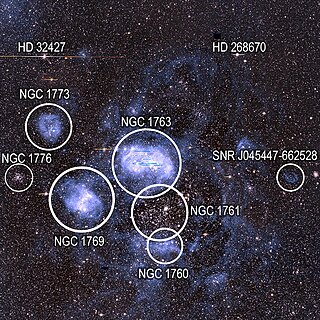
N11 is the brightest emission nebula in the north-west part of the Large Magellanic Cloud in the Dorado constellation. The N11 complex is the second largest H II region of that galaxy, the largest being the Tarantula Nebula. It covers an area approximately 6 arc minutes across. It has an elliptical shape and consists of a large bubble, generally clear interstellar area, surrounded by nine large nebulae. It was named by Karl Henize in 1956.



















